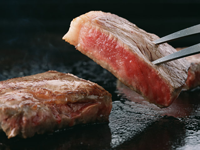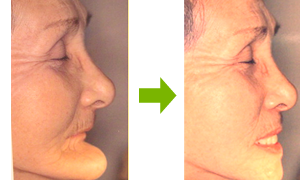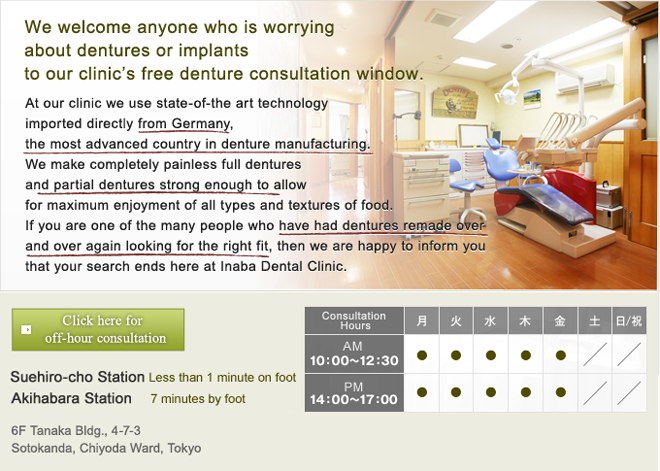トップへ » Considering Dentures? » Full Dentures, a Strong Bite, and a Beautiful Smile
Can you eat anything with your current dentures?
Can you eat steak or firm bread with the full dentures you are using now? Can you eat anything you want with your current dentures?
 It is not so difficult to bite into hard foods, but it can be difficult eating foods that require some chewing.
It is not so difficult to bite into hard foods, but it can be difficult eating foods that require some chewing.
It is said that biting directly into foods that have a slight crunch, such as spring rolls and pies, or fruit with the skin on it, is very difficult with dentures. Some people find it difficult to bite into vegetables like lettuce.
Can you laugh or speak in a loud voice in front of people?
Many patients with full dentures worry about them falling out, have difficulty speaking clearly, and shy away from speaking in the presence of other people. This can have unfortunate consequences on their lifestyles.
Our clinic uses the 'maxillomandibular simultaneous impression method', a method modeled after Strack dentures developed in Germany, in order to provide our patients with the ability to eat what they want to eat, laugh with their mouths wide open, and perform other actions usually taken for granted.
"Full dentures made using the maxillomandibular simultaneous impression method"
The prototype used for "full dentures made using the maxillomandibular simultaneous impression method" were dentures made by Dr. Reiner Strack. Dr. Strack was a master of full denture manufacturing from Tubingen University, the university where Dr. Shigeru Inaba stayed as an exchange student. He was succeeded in his craft by Dr. Hans Schleich.
When Dr. Strack retired, all of his research materials were entrusted to Dr. Shigeru Inaba. Currently Dr. Shigeru Inaba is the only dentist who teaches the manufacturing process of Dr. Strack's dentures in their original design. Dr. Shigeru Inaba has transmitted this knowledge to dentists throughout Japan.
Pattern of patient training of three days here
Dentures that truly fit will give you a brighter face
People who have lost all of their teeth tend to look older since the bone around their mouths thins out and causes an emaciated look.
Dentures that are made with patients' bone quality and mouth movements in mind can restore those patients' features lost due to tooth decay.
Strack dentures made using the 'maxillomandibular simultaneous impression method' can add volume to the inner mouth which enables the dentist to adjust the appearance of the area around the mouth freely. This means that patients are able to have their youthful appearances restored.

 Dentures that fit correctly can actually change peoples' expressions. When patients remove their dentures, the area around their mouths sinks and they look older than they are. But with full dentures, they will look noticeably younger and brighter.
Dentures that fit correctly can actually change peoples' expressions. When patients remove their dentures, the area around their mouths sinks and they look older than they are. But with full dentures, they will look noticeably younger and brighter.
 Strack dentures are superior esthetically as well as functionally.
Strack dentures are superior esthetically as well as functionally.
We make full dentures that allow our patients, young and old, to enjoy eating and talking every day.
Don't think of getting dentures as 'giving up'. The picture to the right shows one of our patient's beautiful smiles right after she got dentures. This smile says all that needs to be said about the comfortable fit of our dentures. A comfortable mouth will lead to a brighter disposition.
Our clinic provides the best treatment available to make sure that your patients can regain the comfortable smiles that they had before they lost their teeth.
We make German-style full dentures designed based on a 3-D model of the mouth
How do you get dentures to firmly stay in place?
Your oral functions are extremely important to eating. The way that you use your tongue and pronounce words is exactly the same with our full dentures as it is would be if you had all of your original teeth. (This drawing comes directly from the master, Dr. Hans Schleich's resources and shows full dentures.)
For example, when people eat, first they press their tongues against the upper jaws and gradually move the food back of the throat for swallowing. In the case of full dentures, these tongue movements make it easy for the dentures to slip out of place, so it is necessary to stabilize the dentures where the tongue comes into contact with them as it is pushing food towards the back of the mouth.
Also, in order to secure dentures and make sure they stay in place, it is best to place prosthetic teeth in the same position that natural teeth were in before they fell out.
How do you create full dentures that are modeled after a mouth with a full set of teeth?
How can we measure mouth movements and the shape of the mouth with all of its teeth when making dentures? The answer is simple. We make a 3-D copy of the condition of the mouth and design dentures that fit perfectly into that model. It's just that easy.
But there are not many dentists who make dentures in this way. The reason for this is that equipment and technology used to make a full 3-D model of the mouth is extremely high-tech.
High-tech mold-taking [maxillomandibular simultaneous impression method]
A mouth with a full set of teeth maintains a good balance with pressure from the cheek muscles pressing in from the outside and pressure from the tongue pushing out from the inside. When people lose their teeth, the cheek muscles continue to push from the sides and the lips from the front, but the tongue no longer has the teeth acting as outer support.
Because of this, the tongue tends to spread out more than when teeth were still present creating the illusion that there is no room for teeth. This makes taking a mold of the oral condition without teeth very difficult.
However, our clinic's 'full denture manufacturing method through maxillomandibular simultaneous impression method' is calibrated to account for the patient's original muscular state which gives us a perfect recreation of the patients teeth made from their own natural mouth movements.
What do you mean by a method that perfectly reproduces the inside of the mouth?
We make our dentures keeping in mind the way the mouth moves when 'swallowing'
Try to imagine the way that muscles in our mouths move when we eat. It is easy to imagine if you swallow some saliva. Our clinic's full dentures are designed with these 'swallowing' mouth movements in mind.
You may think, "How on earth can you model swallowing movements?" When we use the 'maxillomandibular simultaneous impression method' to take a mold of your mouth, we will ask you to swallow. Of course this was impossible to do with the conventional modeling procedure where molds were taken of the upper jaw and lower jaw separately.
And, of course there are some preparations that need to be made before taking the final mold. Beforehand we must confirm the height of the dentures and whether or not they are centered and bilaterally symmetrical. Then we can use this information to make a specialized tray.
Dentures that provide the tongue with full natural movement
One of the disadvantages of conventional dentures is that in order to achieve stability, the shape of dentures was typically extended to reach behind the tongue in the lower jaw. The dentures would not come out if the tongue was not moving but even if the tongue moved slightly, they were in danger of slipping out of place. It is impossible not to worry about every tongue movement under these conditions.
However, full dentures made with the 'maxillomandibular simultaneous impression method' make use of the soft area towards the front of the tongue, leaving the tongue to move freely.
Also, when people lose their teeth, their bone becomes thinner. The part of the dentures known as the bed (the pink plastic part) makes up for this. The more area the bed has, the stronger the adsorption power of the dentures.
How are your dentures?
Superior dentures are made by lining up artificial teeth where they can maximize adsorption and maintain a balance between the support of cheek muscle force, the lips, and the tongue.
If this balance is off, only the lower teeth may be visible when smiling, or one's facial expression may appear squished with a lowered bite. The ideal denture shape should allow for all teeth to be seen when smiling.
カテゴリー一覧
- Considering Dentures?
- Full Dentures, a Strong Bite, and a Beautiful Smile
- Unnoticeable Partial Dentures
- Dentures in Your 30s
- Resilience Telescope
- Konus Krone
- Lab Intec, Onsite Dental Technician Office
- What is the Telescopic System?
- Process of Getting Dentures
- Worrying about Implants
- Different from Insurance Covered Dentures
- Denture Maintenance
- Dentures and TMJ Arthrosis
- Questions about Dentures
- Inquiries from Overseas
- Case Introductions
- Hear from Our Patients
- Costs
- Concerning Medical Expense Deductions
- Our Clinic
We hold free consultations for dentures.

トップへ » Considering Dentures? » Full Dentures, a Strong Bite, and a Beautiful Smile









